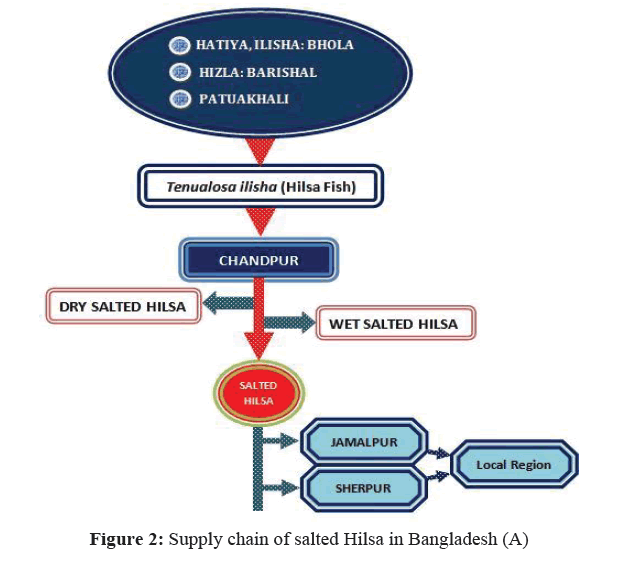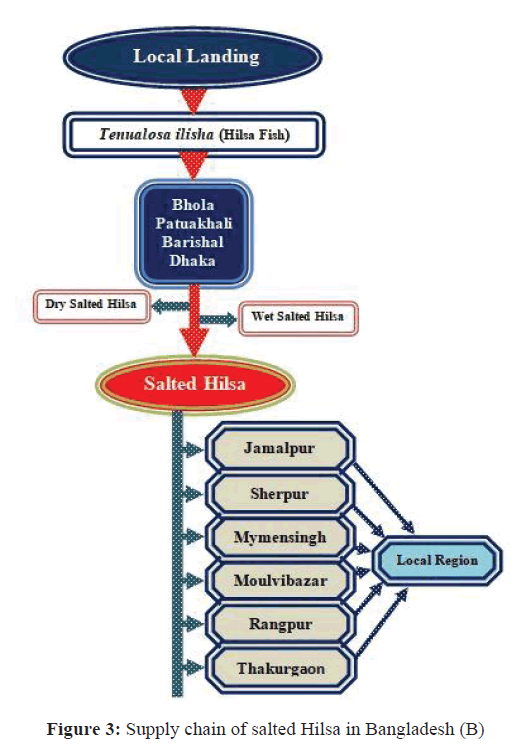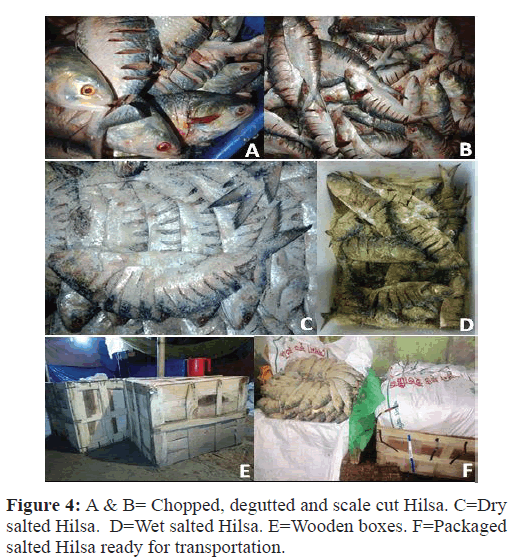Abstract
Hilsa (Tenualosa ilisha) is the single largest fishery of Bangladesh and very popular food fish. Chandpur is very famous for Hilsa hence it is called the “City of Hilsa”. The study was conducted from July 2016 to December 2016 with a view to knowing the salting process and determining the supply chain analysis of salted Hilsa for better management of this trade. A structured questionnaire was used during primary data collection and the fishermen, fisher folk, fish retailer and other associated personnel were interviewed directly. From the daily newspapers of Bangladesh both local and national, secondary data were collected. Hilsa is processed in two forms; dry salted and wet salted. The salted Hilsa are then traded in the country mainly to the buyers from Sherpur and Jamalpur districts by truck or pick-up. Depending on the number of boxes, salted Hilsa are transported through mini, medium and big truck in which maximum capacity of each box is 160 kg. From these two districts salted Hilsa are sold to district buyer at 250-300 taka/kg, then to local buyers at 350-400 taka/kg and finally to local consumers. Salted Hilsa are also prepared in Dhaka, Patuakhali, Barishal, Bhola and sold to the buyers of Sherpur, Jamalpur, Mymensingh, Moulvibazar, Rangpur and Thakurgaon districts. Salted Hilsa can become an exportable value added product and foreign currency can be earned by exporting salted Hilsa.
Keywords
Hilsa; Salted Hilsa; Nona ilish; Tenualosa ilisha; Supply chain; Bangladesh
Introduction
Hilsa (Tenualosa ilisha) is the single largest fishery of Bangladesh and it plays a vital role in national economy and employment to the people of Bangladesh (Haldar, 2001). The contribution of Hilsa to the total fish production and to GDP is about 12% and 1% respectively. For the livelihood purpose, about 2% of the total population of the country is directly or indirectly involved in the fishery (DoF, 2018). Bangladesh represents about 60% of global Hilsa production in terms of Hilsa catches (Hossain, 2014).
The Bangladeshi people are called “Mache vate Bangali” meaning “Fish-Rice Bengali”. Among the fishes Hilsa fish is a very popular and tasty fish in Bangladesh (Mustafa et al., 2012). Hilsa has mouthwatering flavor and superb mouth feel which made the fish “Macher raja Ilish” which means “Hilsa is the king of fish” in Bangladesh (Mukit, 2016). Hilsa has secured recognition as the second Geographical Indication (GI) product of Bangladesh and globally it is now registered as a fish of Bangladesh (Matin and Shamim, 2018).
Hilsa has been designated as the national fish of Bangladesh and it is species of culture in Bangladesh (Rahman et al., 2017). Nowsad (2007) stated Hilsa has highly preferred taste than most other fishes due to its typical biochemical composition especially fatty acid composition. Because of its excellent flavor and delicatetaste, Hilsa has a universal appeal to the consumer (Rahman et al., 1999).
As Hilsa is too oily for drying it is often processed by salt curing and salted Hilsa is locally known as ?Nona Ilish?. Because of its characteristic flavour and taste, most consumers prefer the product (AOAC, 1975). Salting is done not only to extend the shelf life of fresh fish but also to provide desirable sensorial changes (Andres et al., 2005).
Chandpur is very famous for Hilsa hence it is called the “City of Hilsa”. Huge Hilsa fishes are landed at Chandpur Fish Landing Center which makes it one of the biggest Hilsa landing centers in the country. Because of both its taste and nutritional quality, salted Hilsa has a relatively high demand of than other fishes in Bangladesh.
No specific research work has been done and very few relevant literatures found on Hilsa salting process and its trade in Bangladesh. The study aims at determining the salting process and analyzing of the supply chain of salted Hilsa for better management of this trade.
Methodology
Time period
The study was conducted from July 2016 to December 2016.
Sampling site
Chandpur district was selected for the study because of huge Hilsa landing and people from different regions comes here to process and buy the salted Hilsa.
Data collection
A structured questionnaire was used during primary data collection and the fishermen, fisher folk, fish retailer and other associated personnel were interviewed directly about the collection, processing and preservation, transportation, trade channel. From the daily newspapers of Bangladesh both local and national, secondary data were collected for the crosscheck. The following topics were considered during data collection.
Collection system of Hilsa
The collection system of Hilsa for salting purpose was determined.
Processing and preservation system of salted Hilsa
The processing and preservation system of salted Hilsa were figured out.
Transportation system of salted Hilsa
The transportation system of salted Hilsa was also known.
Trades of salted Hilsa
How trade of salted Hilsa is done and who are involved with the process were figured out.
Supply chain analysis of salted Hilsa
Supply chain analysis of salted Hilsa was assessed and determined for better understanding of trade channel.
Trade channel of salted Hilsa in other regions
Trade channel of salted Hilsa in the other regions was also determined.
Results and Discussion
Collection system of Hilsa
Chandpur Fish Landing Center (locally known as Mach ghat) located in Boro Station situated at the bank of River Dakatia is one of the biggest landing centers where Hilsa fish exploited from different rivers in different regions and different landing centers are landed in plenty. Considering the quality, some Hilsa fishes are found to be lower grade (Arman et al., 2018). Due to inadequate preservation and improper handling in the fishing boat, those Hilsa fishes are collected and salted for better preservation and benefits which is called Nona ilish (Ahmed, 2016). After the completion of salting process separated eggs are processed in the other trade channel.
Processing and preservation system of salted Hilsa
One of the traditional methods used for preserving fatty fish is salting because of its ability to create unfavorable environment for the growth of microorganisms by lowering the water activity of the fish muscle. By reducing the water activity (aw) through salting which then inhibits the growth of spoilage microorganisms and inactive the autolytic enzymes (Horner, 1997).
At first, the collected Hilsa fish is scaled and the fins are removed. Then by a sharp fish-knife the fish is cut transversely from the dorsal to the ventral region. This process is done in such a way that head remains intact with the body. The chunks also remain attached at the abdominal keel bone region. The guts are removed from the abdomen and the eggs are separated if there are eggs. Sufficient amount of salt is added to the fish gills, mouths, eyes and abdomen and in between each chunk. The study concluded that 25% of NaCl of total Hilsa fish body weight was suitable for good quality and maturing of salted Hilsa (Mukit et al., 2016). Then the salted Hilsa are kept stacked in rectangular shape in the room temperature for 7-8 days for drying. The dry salted Hilsa are packed in the sacks which are then packed in the wooden boxes. Each box’s holding capacity is about 140-160 kg of salted Hilsa. In case of wet salting, salted Hilsa are preserved in the previously prepared salt-water solution (water: salt=100 kg: 30 kg) for 5-6 months in plastic drum. Each drum can hold about 140-160 kg of salted Hilsa fish. Then this Hilsa fish are sold to the local buyers, consumers etc. In several tin shade rooms in the fish landing center, the whole process is done.
In some other regions rather than Chandpur, turmeric powder is sprinkled over the cut and degutted Hilsa fish during the preparation of dry salted Hilsa.
Transportation system of salted Hilsa
After that, the wooden boxes are transported to districts by truck or pick-up. Depending on the number of boxes, fishes are transported through mini, medium and big truck (Table 1).
Trades of salted Hilsa
The prices of salted Hilsa from producer to consumer is shown in Figure 1.

Figure 1:Trade Channel of salted Hilsa
Supply chain analysis of salted Hilsa
In the Fish Landing Center of Chandpur, Bangladesh; Hilsa fish (Tenualosa ilisha) are landed from Hilsa abundant regions mainly Hatiya, Ilisha: Bhola, Hizla: Barisal, Patuakhali. In downstream areas and especially the inshore waters, Hilsa fishing intensity has been increasing because of sufficient concentrations of Hilsa in these areas (Halder, 2004). Lower graded Hilsa in terms of quality are separated from the landed Hilsa and collected. The collected Hilsa are then salted and traded in the country mainly to the buyers from Sherpur and Jamalpur districts. From these two districts salted Hilsa are sold locally (Figure 2).

Figure 2:Supply chain of salted Hilsa in Bangladesh (A)
Trade channel of salted Hilsa in other regions: Salted Hilsa are also prepared in Dhaka, Patuakhali, Barishal, Bhola and sold to the buyers of Sherpur, Jamalpur, Mymensingh, Moulvibazar, Rangpur and Thakurgaon districts (Figures 3 and 4).

Figure 3:Supply chain of salted Hilsa in Bangladesh (B)

Figure 4:A & B= Chopped, degutted and scale cut Hilsa. C=Dry salted Hilsa. D=Wet salted Hilsa. E=Wooden boxes. F=Packaged salted Hilsa ready for transportation.
Recommendations and Conclusion
The country’s most important aquatic resource is Hilsa. In Bangladesh the demand of salted Hilsa is good and is traded in some regions. Salted Hilsa can become an exportable value added product and foreign currency can be earned by exporting salted Hilsa.
Acknowledgement
The authors are thankful to the Hilsa fish traders of fish landing center Chandpur, District traders of Sherpur and Jamalpur and the workers in the supply chain.
25407
References
- AOAC. (1975) Official Methods of Analysis (12th Edition) Association Official AnalyticalÃÂÃÂÃÂâÂÂÃÂâââÂÂìÃÂ
áÃÂÃÂââ¬Ã
¡ÃÂâÂÂÃÂàÃÂÃÂÃÂâÂÂÃÂâââÂÂìÃÂ
áÃÂÃÂââ¬Ã
¡ÃÂâÂÂÃÂàÃÂÃÂÃÂâÂÂÃÂâââÂÂìÃÂ
áÃÂÃÂââ¬Ã
¡ÃÂâÂÂÃÂàÃÂÃÂÃÂâÂÂÃÂâââÂÂìÃÂ
áÃÂÃÂââ¬Ã
¡ÃÂâÂÂÃÂàÃÂÃÂÃÂâÂÂÃÂâââÂÂìÃÂ
áÃÂÃÂââ¬Ã
¡ÃÂâÂÂÃÂàChemists, Washington D.C. pp: 836
- Andres, A., Barona, S. R., Barat, J.M., Fito, P. (2005) Salted cod manufacturing: Influence of salting procedure on process yield and product characteristic. J Food Eng 69, 467-471.
- Arman Hossain, A.B.M., Bisshas, S., Pramanik M.M.H., Hasan, M.M., Haidar, M.I., et al. (2018) Supply Chain Analysis of Hilsa (Tenualosa ilisha) Egg in Bangladesh. J Fish Sci 2(4), 9-12.
- DoF. (2018) National fish week 2018 compendium (In Bengali). Department of Fisheries, Ministry of Fisheries and Livestock, Bangladesh.
- Haldar, G.C., Mazid, M.A., Rahman, M.A., Amin, S.M.N. (2001) The present Status of the Hilsa (Tenualosa ilisha) Fishery in Bangladesh. Proceedings of the International Terubok Conference, Sarawak, Malaysia. pp:52-64.
- Halder, G.C. (2004) Present status of the hilsa fishery in Bangladesh. Completion report of the studies conducted under the ARDMCS, GEF component and FFP, Report No. 38.8. Dhaka: Department of Fisheries, Bangladesh.
- Horner, W.F.A. (1997) Preservation of Fish by Curing, Drying, Salting and Smoking. In: Fish Processing Technology (2nd Edition). G.M. Hall, Blackie Academic and professional, London. pp:32-73.
- Hossain, M.K. (2013) TOWARD OPTIMAL USE OF BANGLADESH HILSA RESOURCE: BIOECONOMIC MODELLING. Final project, United Nations University, Fisheries Training Programme, Iceland.
- Matin, S., Shamim, S.H. (2018) Geographical Indications in Bangladesh Supply Chain: What Needs to Be Done Now? Int J Sup Chain Mgt 7(6), 591-599.
- Mukit, S.S., Hoque, M.S., Roy, S., Rahman, M.B., Suprakash, C. (2016) Effects of different types and concentrations of salt on the quality aspects of salted hilsa (Tenualosa ilisha). Int J Inno Res 1(1), 30ÃÂÃÂÃÂâÂÂÃÂâÂÂÃÂâÃÂÃÂââ¬Ã
¡ÃÂâââ¬Ã
¡ÃÂìÃÂÃÂââ¬Ã
¡ÃÂâââÂÂìÃÂ
âÂÂ39.
- Mustafa, M.G., Begum S.R., Khaleque, M.A., Jannat, M., Ahsan, D.A. (2012) Nutritional Quality of Hilsa and Sarpunti in Different Salt Curing Methods. Dhaka Univ J Biol Sci 21(1), 97-104.
- Nowsad, A.K.M. (2007) Participatory Training of Trainers: ÃÂÃÂÃÂâÂÂÃÂâââÂÂìÃÂ
áÃÂÃÂââ¬Ã
¡ÃÂâÂÂÃÂàA New Approach Applied in Fish Processing. Bangladesh Fisheries Research Forum. pp: 329.
- Rahman, M.A., Hossain, M.A., Mansur, M.A. (1999) Effects of different salting methods on the nutritional and sensory characteristics of Hilsa (Hilsa ilisha). Indian J Mar Sci 29, 171-175.
- Rahman, M.A., Pramanik, M.M.H., Flura Ahmed, T., Hasan, M.M., Khan M.H., et al. (2017) Impact Assessment of Twenty-Two Days Fishing Ban in the Major Spawning Grounds of Tenualosa ilisha (Hamilton, 1822) on its Spawning Success in Bangladesh. J Aquac Res Development 8, 489.










